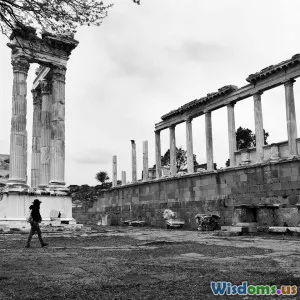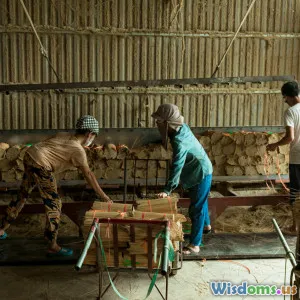
Archaeology's Greatest Discoveries and Their Impact
9 min read Explore monumental archaeological discoveries reshaping our understanding of ancient civilizations. (0 Reviews)
Archaeology's Greatest Discoveries and Their Impact
Archaeology provides a window into the lives of those who came before us. This intriguing field has produced findings that offer insights into ancient civilizations, societal structures, and cultural practices. Among the wide-ranging discoveries made throughout time, a select number stand out for their profound impact on our understanding of history. Let us journey through some of the most significant archaeological findings and discover how they shape our knowledge of humanity.
The Tomb of Tutankhamun
The discovery of Tutankhamun’s tomb in the Valley of the Kings in 1922 by British archaeologist Howard Carter revolutionized our understanding of Egyptian burial practices and art. Aside from uncovering the opulence associated with pharaonic tombs—gold sarcophagi, exquisite jewelry, and artifacts that showcased the era’s artistry—the tomb’s contents provided a invaluable insight into ancient Egyptian beliefs regarding the afterlife. The inscriptions and artwork not only enhanced our knowledge about the ritual practices of Egyptians but also highlighted the reign of a relatively obscure pharaoh.
Moreover, the discovery sparked a fascination with ancient Egypt that persists today, leading to numerous exhibitions and a wealth of further research.
The Rosetta Stone
Discovered in 1799 by French soldiers during Napoleon's Egyptian campaign, the Rosetta Stone is one of archaeology’s most famous artifacts. This inscribed stone tablet features a decree issued in Memphis, Egypt, in multiple scripts (Greek, Demotic, and hieroglyphic). The key impact of the Rosetta Stone on archaeological inquiry cannot be overstated: it was pivotal in deciphering Egyptian hieroglyphs, a writing system that had remained a mystery for centuries.
Sir Thomas Young and Jean-François Champollion were among the scholars who unlocked the secrets of the inscriptions. This breakthrough not only allowed for a deeper understanding of ancient Egyptian civilization and its contributions but vastly expanded the field of Egyptology.
Machu Picchu
Machu Picchu, the iconic Incan citadel located in the Andes Mountains of Peru, was brought to global attention by American historian Hiram Bingham in 1911. Although the site had been known to locals, Bingham’s expedition unveiled the splendor of Incan engineering and advanced urban planning, showcasing terraces, agricultural practices, and religious structures.
Machu Picchu's discovery ignited interest in Inca history and culture and substantially contributed to the understanding of their societal organization. Scholars continue to study the site to learn more about Inca agricultural, astronomical, and architectural practices, which have crucial implications for current and future indigenous rights and conservation efforts.
Gobekli Tepe
Located in Türkiye, Gobekli Tepe is considered one of the oldest known temple complexes in the world, dating back over 11,000 years. Discovered in the mid-1990s by Klaus Schmidt, this archaeological site challenges long-held beliefs about the timeline of human civilization. Previously, it was widely believed that organized religious practices emerged after the advent of agriculture and settled living. However, Gobekli Tepe suggests that such spiritual gatherings began while humanity was still predominantly nomadic.
The intricately carved T-shaped pillars at Gobekli Tepe depict various animals and symbols, presenting a mosaic of symbols that offers insights into the cultural and social structures of early human societies. Its excavation has expanded scholarly discussion around the development of human society, bringing new light on the role of spirituality in civilization's evolution.
The Dead Sea Scrolls
After their discovery in the late 1940s in caves near the Dead Sea, the Dead Sea Scrolls have had an enduring impact on our understanding of Judeo-Christian history. These ancient manuscripts date from around the 3rd century BCE to the 1st century CE and encompass a collection of texts from the Hebrew Bible and other religious writings.
Their significance lies not only in the content's religious implications but also in their contribution to biblical scholarship, validating versions of Old Testament texts and providing insights into the Jewish culture and sects during the Second Temple period. The scrolls have prompted extensive research, reshaping theological discourse as well as insights into the historical context of Christianity’s nascent years.
The Terracotta Army
In 1974, a group of Chinese farmers unearthed the Terracotta Army, buried near the tomb of Qin Shi Huang, the first emperor of China. This incredible discovery includes thousands of life-size figures, each uniquely crafted to represent soldiers and horses. The army, intended to protect the emperor in the afterlife, illustrates the level of artistry and the military organization of Imperial China.
The Terracotta Army not only underscores the importance of funerary practices in ancient Chinese culture but provides crucial insights into the political and social structures of the time. The find has spurred unprecedented tourism and scholarship centered on ancient China, driving efforts to preserve cultural heritage against globalization's pressures.
Stonehenge
One of the world’s most recognized landmarks, Stonehenge is an archaeological marvel located in Wiltshire, England. This prehistoric monument's purpose has long puzzled archaeologists; however, recent studies suggest it served as a ceremonial site aligning with solstices, which indicates the advanced understanding of astronomy by the people who built it. Its continuous exploration sheds light on Neolithic societies and their spiritual lives.
Fascination with Stonehenge continues, inspiring modern iterations of ancient practices and drawing significant tourism, which helps to fund preservation efforts. Each excavation and new find around the site contributes depth to our understanding of the complex human landscape of ancient Britain.
Conclusion
The remarkable discoveries outlined here represent mere glimpses into the vast tapestry of human history etched into the Earth's fabric. Each artifact not only provides evidence for specific cultural practices and beliefs but also serves to bridge the gap between ancient civilizations and modern perspectives. Through these vestiges of the past, archaeology fosters curiosity and encourages intrinsic exploration of the journey humanity undertakes through time.
As we uncover more secrets from beneath the earth, we deepen our understanding of ourselves, our origins, and how historical narratives continue to shape our present. Every rock turned, every tomb opened, and every script deciphered breathe new life into the ancient world and its timeless mysteries.
Rate the Post
User Reviews
Popular Posts





















